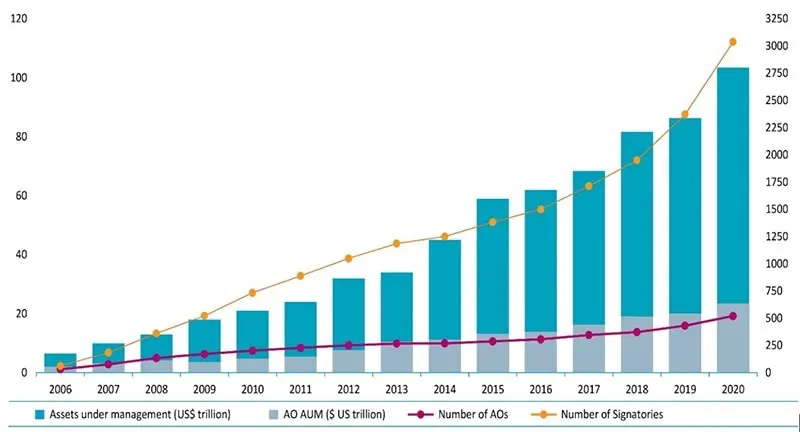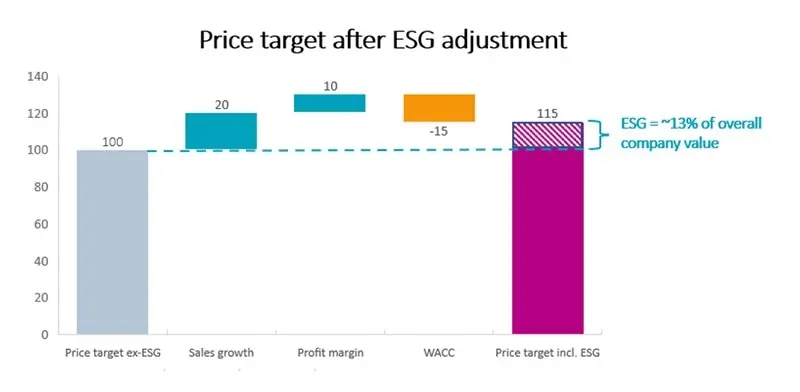Figure 1: The growth of ESG incorporation into investment decisions

Source: PRI, 2020.
In 2006, when the UN-backed ‘Principles for Responsible Investment’ (PRI) initiative was launched, only 63 investment companies, with USD 6.5 trillion in assets under management (AUM), committed to incorporate ESG criteria into their investment decisions. By the end of 2020, the number of signatories had grown to over 3,000, representing USD 100 trillion in AUM. Globally, around USD 30 trillion worth of professionally managed assets are now subject to some type of ESG criteria.1
This raises the question of measuring ESG’s contribution to investment performance. This is easier said than done as a myriad of reasons may explain a stock’s recent returns, including ESG. Therefore, isolating the impact of ESG integration on performance is extremely difficult. More traditional attribution analyses usually focus on allocation (whether by country, sector or some other specified segment), stock selection and interaction effects.
A unique methodology
To address this burning issue, Robeco has designed a methodology. Although it does not conclusively measure ESG’s impact on investment returns, it provides a good initial stab at extrapolating its contribution to a stock’s performance. This methodology considers both the influence of ESG on the target prices in our investment cases and the impact of the exclusion of controversial companies from the investable universe.
We start by measuring how much of a firm’s target price can be attributed to ESG variables. This is done through integrating ESG into our valuation model, whereby we can calculate how much it impacts the total valuation (see Figure 2). To get a proxy for the ESG contribution to the overall relative performance of a stock, we multiply this ESG impact by the stock’s total attribution, over the selected time period.
Figure 2: Valuation adjustments due to ESG variables

Source: Robeco.
For example, assume that our price target analysis shows that ESG accounts for 20% of a company’s forecasted valuation. If the relative performance contribution of that stock in the portfolio has been +150 basis points (bps) over a certain period, then multiplying both figures together will represent the excess performance attributable to ESG. In our example, this turns out to be 30 bps (20% x 150 bps).2
Next, we measure the impact of Robeco’s exclusion policy on performance by simply summing the attribution of the excluded stocks over the period considered. Finally, the last step in our methodology is to add the impact of ESG variables on target prices and the effect of exclusions on portfolio performance, to calculate what we believe is a good representation of ESG’s impact on performance.
Positive impact across the board
Our results suggest that ESG has been a key performance driver for both our Sustainable Global Stars and Sustainable Emerging Stars strategies. For instance, ESG explained about 19%, or 432 bps, of the cumulative 2,329 bps of active returns of our Sustainable Global Stars strategy, over the 2017-2020 period. ESG also contributed more than 60%, or 233 bps, of the cumulative 357 bps of excess performance of our SES strategy since inception in September 2019.
Of course, we do not claim to have found a definitive method to isolate ESG’s impact on equity returns, but we do believe that our approach is a sensible and useful first step. Disclaimers aside, our analysis suggests that during the observed time periods – admittedly relatively short ones – a significant share of any excess performance can be attributed to ESG. Taken together, these results make a powerful argument that ESG has a positive impact on investment performance.
Footnotes
1 Source: PRI, 2020.
2 Past performance is not a reliable indicator of future results.




















